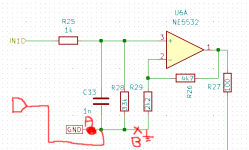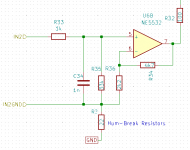I think you said you dumped the DCX. I had one, Biggest POS I ever owned. Long boot, hum, sounded terrible. I switched their analog crossover which I did not care for anyway. I now use X-Kitz my main/sub. Probably right, the supply may be doing it.
I have been testing the Liner Tech USB isolation demo board. It does work very well if you have a USB problem. They can't fix problems that don't exist.
I have been testing the Liner Tech USB isolation demo board. It does work very well if you have a USB problem. They can't fix problems that don't exist.
I think you said you dumped the DCX. I had one, Biggest POS I ever owned. Long boot, hum, sounded terrible. I switched their analog crossover which I did not care for anyway. I now use X-Kitz my main/sub. Probably right, the supply may be doing it.
I have been testing the Liner Tech USB isolation demo board. It does work very well if you have a USB problem. They can't fix problems that don't exist.
"Died" more than dumped, but yes. It never had a hum though, just a disappointingly high level of white noise.
Don't reckon I need any USB isolation at the moment.
@laplace ground loop doesn't happen because of connection to the earth (protective earth), it happens because of multiple same path in your application (your amp design).
Now you have negative input of your balance amp input multipy times connected to one ground (in your DSP). What is that?
With ground of your amps connected to the same point (chassis) you didn't have influence on your input signal because you used balanced input. Now you have single ended connection (asymmetric one) when one input (negative) is connected to the source signal to the gnd and from another amp is the same, your amp 1 and amp 2 gnd is connected to the same point. Try to lift one of these gnd and see what is going to happen.
Maybe try - input connected to the gnd in your amp connector.
What will solve your problem for sure is using audio transformers on each input (single ended to balanced).
Now you have negative input of your balance amp input multipy times connected to one ground (in your DSP). What is that?
With ground of your amps connected to the same point (chassis) you didn't have influence on your input signal because you used balanced input. Now you have single ended connection (asymmetric one) when one input (negative) is connected to the source signal to the gnd and from another amp is the same, your amp 1 and amp 2 gnd is connected to the same point. Try to lift one of these gnd and see what is going to happen.
Maybe try - input connected to the gnd in your amp connector.
What will solve your problem for sure is using audio transformers on each input (single ended to balanced).
Last edited:
pitbul: the DSP is floated, except for its inputs. The amp GND is not connected to the DSP GND because the inputs are differential. By default, the DSP GND will follow the GND of its source... but also it internally makes a low-impedance connection between that and USB GND. Plugging in the USB therefore forms a loop, but it is not causing problems. I am not inserting transformers; they are unnecessary in this use case.
... segue ...
Related question about UNBALANCED input circuits now - attached is a screengrab from the schematic of a preamp input circuit. Taking the guidance from the Hifisonix PDF about "hum breaking resistors", it occurs that I should maybe use one there too.
I assume it must go in the location indicated as A. Am I reading the presentation correctly in saying that the modification marked B is not performed, i.e. the feedback path to "ground" for the input buffer should be on the input side of the HBR? Slide 36 of the Ground Loops PDF, specifically.
This is inside a box which contains the preamp (active crossover) board, plus power amplifiers. Do we expect this to make a significant difference? (I have built and tested the crossover board in isolation but the power-amp boards only just arrived so the complete unit has not been tested)
... segue ...
Related question about UNBALANCED input circuits now - attached is a screengrab from the schematic of a preamp input circuit. Taking the guidance from the Hifisonix PDF about "hum breaking resistors", it occurs that I should maybe use one there too.
I assume it must go in the location indicated as A. Am I reading the presentation correctly in saying that the modification marked B is not performed, i.e. the feedback path to "ground" for the input buffer should be on the input side of the HBR? Slide 36 of the Ground Loops PDF, specifically.
This is inside a box which contains the preamp (active crossover) board, plus power amplifiers. Do we expect this to make a significant difference? (I have built and tested the crossover board in isolation but the power-amp boards only just arrived so the complete unit has not been tested)
Attachments
Post # 25 directly above is correct. I’d go with 10 Ohms for the HBR - try to get away with as little as possible. The interconnect ground connection is usually not more than say 200 mOhms so you will have plenty of cross channel GL noise attenuation even with 10 Ohms.
@laplace

I really don't understand your picture which was attached. DSP outputs are not balanced as I can see... Please clarify DSP GND_OUTx with schematic.
Inputs of your amps are balanced as I understood.
Similar situation I had with my preamp balanced input and noise was higher when I tried to connect something from unbalanced source. Preamp is known brand, so I refused to use this input until I had transformers (suggestion from my own expirience).
As you plan to use audio ground isolation resistor in your input, my advise is that you connect negative input of your balanced input via 10ohm to the audio gnd. Your amp screen is audio GND in your system, because of that I suggested lifting audio gnd of each amplifier via ground lifter (bridge rectifier parallel with 10ohm resistor). Bonsai have this explained graphical in Hifisonix site. His solution helped me a lot.
I really don't understand your picture which was attached. DSP outputs are not balanced as I can see... Please clarify DSP GND_OUTx with schematic.
Inputs of your amps are balanced as I understood.
Similar situation I had with my preamp balanced input and noise was higher when I tried to connect something from unbalanced source. Preamp is known brand, so I refused to use this input until I had transformers (suggestion from my own expirience).
As you plan to use audio ground isolation resistor in your input, my advise is that you connect negative input of your balanced input via 10ohm to the audio gnd. Your amp screen is audio GND in your system, because of that I suggested lifting audio gnd of each amplifier via ground lifter (bridge rectifier parallel with 10ohm resistor). Bonsai have this explained graphical in Hifisonix site. His solution helped me a lot.
I really don't understand your picture which was attached. DSP outputs are not balanced as I can see... Please clarify DSP GND_OUTx with schematic.
Inputs of your amps are balanced as I understood.
Inputs of the amplifier are differential - see the schematic in post #1. They are designed for use with balanced sources, but work equally well with a single-ended source though the gain is a bit low and there is a touch more noise due to all those 10k resistors.
GND_OUTx from the DSP is the RCA screen (sleeve) on the output jack of the DSP. It goes to the negative input of the differential input, but does not connect to ground of the amplifier. The cable screen is connected to the amp chassis, NOT to the DSP RCA sleeve. It is dual-core screened cable, i.e. microphone cable.
I do not currently have an audio GND isolation resistor (per post #25); that's an unrelated system, but the differential input serves the same purpose of not connecting the GNDs. Probably does it with better CMRR too...
So, what I wrote to you is correct, don't ignore my suggestion about ground lifter of the amps gnd in your amp chassis.
Noise is not higher because of the resistors on the inputs of the amps, maybe you should load your dsp output with some load (I would try with 10k and maybe lower value). Experiment.
Noise is not higher because of the resistors on the inputs of the amps, maybe you should load your dsp output with some load (I would try with 10k and maybe lower value). Experiment.
Follow-up after way too long. I ran the (Dayton) crossover from a cheap benchtop switching supply for a while and it was... better, but it still had a distinct and very annoying hum.
I finally got around to putting together a braindead linear supply for the crossover and now the hum is basically gone. The amp is in no way some absolutely perfect thing with a -130dB noise floor, but it's back to a sensible level where you need to stick your ear in the speaker to hear anything that shouldn't be there.
I finally got around to putting together a braindead linear supply for the crossover and now the hum is basically gone. The amp is in no way some absolutely perfect thing with a -130dB noise floor, but it's back to a sensible level where you need to stick your ear in the speaker to hear anything that shouldn't be there.
- Home
- Amplifiers
- Solid State
- Help me with a hum problem?

